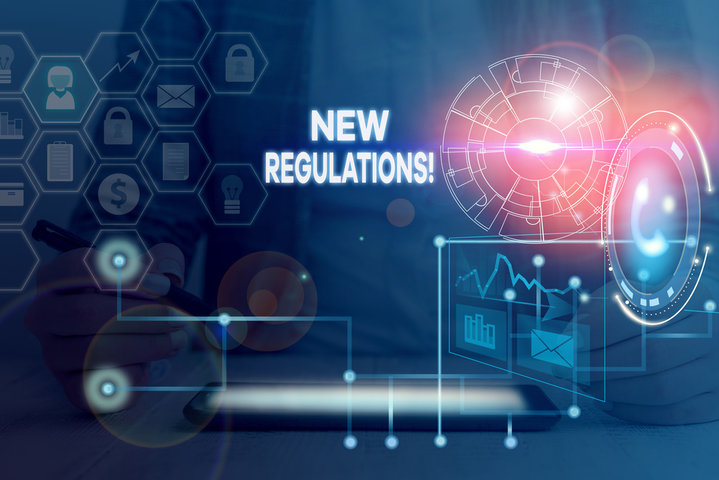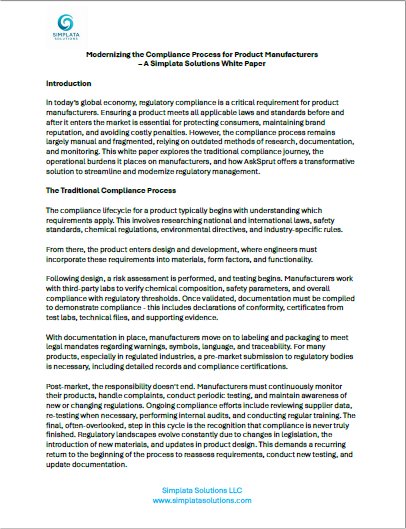
Modernizing the Compliance Process for Product Manufacturers
– A Simplata Solutions White Paper
Introduction
In today’s global economy, regulatory compliance is a critical requirement for product manufacturers. Ensuring a product meets all applicable laws and standards before and after it enters the market is essential for protecting consumers, maintaining brand reputation, and avoiding costly penalties. However, the compliance process remains largely manual and fragmented, relying on outdated methods of research, documentation, and monitoring. This white paper explores the traditional compliance journey, the operational burdens it places on manufacturers, and how AskSprut offers a transformative solution to streamline and modernize regulatory management.
The Traditional Compliance Process
The compliance lifecycle for a product typically begins with understanding which requirements apply. This involves researching national and international laws, safety standards, chemical regulations, environmental directives, and industry-specific rules.
From there, the product enters design and development, where engineers must incorporate these requirements into materials, form factors, and functionality.
Following design, a risk assessment is performed, and testing begins. Manufacturers work with third-party labs to verify chemical composition, safety parameters, and overall compliance with regulatory thresholds. Once validated, documentation must be compiled to demonstrate compliance – this includes declarations of conformity, certificates from test labs, technical files, and supporting evidence.
With documentation in place, manufacturers move on to labeling and packaging to meet legal mandates regarding warnings, symbols, language, and traceability. For many products, especially in regulated industries, a pre-market submission to regulatory bodies is necessary, including detailed records and compliance certifications.
Post-market, the responsibility doesn’t end. Manufacturers must continuously monitor their products, handle complaints, conduct periodic testing, and maintain awareness of new or changing regulations. Ongoing compliance efforts include reviewing supplier data, re-testing when necessary, performing internal audits, and conducting regular training. The final, often-overlooked, step in this cycle is the recognition that compliance is never truly finished. Regulatory landscapes evolve constantly due to changes in legislation, the introduction of new materials, and updates in product design. This demands a recurring return to the beginning of the process to reassess requirements, conduct new testing, and update documentation.
The Manual Burden
Despite advances in many areas of manufacturing, compliance remains heavily manual. Manufacturers must gather regulatory information from scattered sources – government websites, regulatory portals, public databases, legal publications, and even through inquiries with AI tools. These resources are not standardized, and the language used is often dense and inconsistent across jurisdictions. Teams rely on spreadsheets to track changes, manually record supplier certifications, and maintain a history of compliance actions.
Sourcing teams often operate independently of compliance teams, and unless coordinated effectively, materials may be purchased without sufficient vetting. Testing is reactive rather than proactive, and risk is assessed late in the development process, resulting in rework, delays, or worse – noncompliance. Some larger companies invest in third-party research firms or receive insights from testing labs, but these services are often limited in scope and frequency. Small and mid-sized businesses are particularly disadvantaged, lacking the in-house expertise or budget to maintain rigorous compliance oversight. Even third-party providers who sell compliance data typically specialize in niche industries such as medical devices, leaving broad sectors underserved.
This fragmented approach creates significant challenges. The process is costly and time-consuming, requiring dedicated staff and manual labor that could be applied elsewhere. The risk of missing critical regulations is high, leading to potential recalls, fines, or bans from entering markets. Teams suffer from knowledge deficits due to the complexity of laws, and the constant churn in regulatory frameworks makes it hard to stay current. The end result is a resource-intensive burden with a direct impact on a company’s reputation and ability to scale operations globally.
A Modern Solution: AskSprut
AskSprut offers a revolutionary approach to compliance, replacing outdated manual processes with intelligent, automated regulatory management. The platform provides manufacturers access to a curated database of nearly two million global regulations, centralized by industry, product type, and geography. This dynamic repository eliminates the need to chase information across disparate websites and documents and instead offers a single source of truth for regulatory data.
AskSprut’s platform is built for usability and power. Advanced indexing, search, and filtering capabilities allow teams to locate relevant regulations quickly and accurately. Real-time updates ensure that any changes to existing rules – whether minor amendments or major overhauls – are tracked automatically.
A key feature is AskSprut’s smart monitoring dashboard. Users can create saved searches based on keywords, regions, or industries specific to their business. The system continuously monitors these criteria and updates users to new developments, removing the need for repeated manual research. This elevates AskSprut from a passive database into a proactive compliance radar, enabling businesses to stay ahead of new rules and respond with agility.
By integrating AskSprut into their workflows, manufacturers can reduce compliance gaps, minimize legal risk, and eliminate the hidden costs of manual compliance management. Teams are empowered with timely, actionable data and can redirect their focus to product innovation and market expansion rather than regulatory firefighting.
Conclusion
The compliance process for product manufacturers is essential but often overwhelming. Traditional, manual approaches place significant strain on teams and create unnecessary exposure to risk. As regulations multiply and global markets become more interconnected, the need for a smarter, centralized, and scalable compliance solution has never been more urgent.
AskSprut addresses this need head-on by providing a comprehensive platform that transforms how organizations approach regulatory research, monitoring, and management. With AskSprut, compliance is no longer a scattered and reactive task – it becomes a strategic asset that supports growth, protects brand value, and ensures operational confidence in a constantly evolving world.
About Simplata Solutions
Simplata Solutions transitions data into knowledge in all industries and areas of like. The company brings together a team of data, cybersecurity, and testing, inspection, and certification experts serving global retailers, manufacturers, and suppliers. Our solutions help customers manage complex data to ensure their ability to sell in global and local markets.
AskSprut is a platform that provides you and your organization centralized accessible regulations by product type and/or geographical region, automated and updated lists of regulations, and processes to stay current on regulatory changes. The platform features dynamic data, search and query capabilities, indexing and full-text search, and versioning and change tracking for regulatory monitoring.
Download your copy today!

